
The Atlantic blue marlin is a species of marlin endemic to the Atlantic Ocean. It is closely related to, and usually considered conspecific with, the Indo-Pacific blue marlin, then simply called blue marlin. Some authorities still consider both species distinct.

The black dogfish is a species of dogfish shark in the family Etmopteridae. It is common over the outer continental shelf and continental slope at depths of 180–2,250 m (590–7,380 ft). Females generally inhabit deeper water than males, and depending on the region, smaller sharks may occur at different depths than larger ones. This species is distributed widely in the Atlantic Ocean, from Greenland and Iceland to Virginia and West Africa in the north, and off southwestern Africa and Argentina in the south. The largest member of its family, the black dogfish, typically measures 60–75 cm (24–30 in) long. It has a stocky, dark brown body that is darker below than above, and bears scattered, minute bioluminescent organs. Its two dorsal fins are preceded by stout spines, and the anal fin is absent.

The redfingers is a species of marine ray-finned fish, belonging to the family Cheilodactylidae, commonly referred to as morwongs. It is found only off the coasts of Namibia and South Africa, in rock pools and from shallow depths to 120 m, on rocky reef areas. Its length is up to 30 cm.
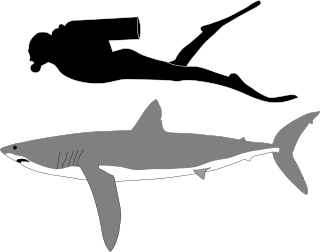
The longfin mako shark is a species of mackerel shark in the family Lamnidae, with a probable worldwide distribution in temperate and tropical waters. An uncommon species, it is typically lumped together under the name "mako" with its better-known relative, the shortfin mako shark. The longfin mako is a pelagic species found in moderately deep water, having been reported to a depth of 220 m (720 ft). Growing to a maximum length of 4.3 m (14 ft), the slimmer build and long, broad pectoral fins of this shark suggest that it is a slower and less active swimmer than the shortfin mako.

Latris lineata, the striped trumpeter, common trumpeter, copper moki, Hobart-town trumpeter, kokikohi, real trumpeter, Tasmanian striped trumpeter or Tasmanian trumpeter, is a species of marine ray-finned fish belonging to the family Latridae, the trumpeters. It is native to rocky reefs in the temperate oceans of the southern hemisphere.

The Australian weasel shark is an uncommon species of ground shark in the family Hemigaleidae. It inhabits shallow waters off northern Australia to a depth of 170 m (560 ft); smaller sharks frequent sand and seagrass habitat and shift to coral reefs as they grow older. A slim, drab species reaching a length of 1.1 m (3.6 ft), it has sickle-shaped fins with dark tips on the second dorsal fin and caudal fin upper lobe. Its upper teeth are broad with strong serrations only on the trailing edge. The lateral line along each side is prominent and exhibits a downward curve below the second dorsal fin.
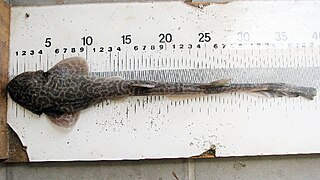
The Izak catshark or simply Izak is a species of catshark, belonging to the family Scyliorhinidae, common off the coasts of South Africa and southern Namibia. It typically inhabits the outer continental shelf at depths of 100–300 m (330–980 ft), with the males found deeper than the females and juveniles. The Izak catshark has a short, wide, flattened head and a robust body tapering to a long, slender tail. It can be identified by its ornate color pattern of dark brown spots or reticulations and blotches on a light yellowish background, as well as by the enlarged dermal denticles over its pectoral fins and along its dorsal midline from the snout to the second dorsal fin. This species reaches 69 cm (27 in) in length, with the males larger than females.

The longnose pygmy shark is a rare species of squaliform shark in the family Dalatiidae and the only member its genus. It is known only from a handful of specimens collected from the cold oceanic waters of the Southern Hemisphere, between the surface and a depth of 502 m (1,647 ft). Reaching 37 cm (15 in) in length, this diminutive shark is characterized by a slender, dark brown body with a very long, bulbous snout. In addition, it has two spineless dorsal fins of nearly equal size, with the origin of the first lying over the pectoral fin bases. The longnose pygmy shark does not appear substantially threatened by fisheries, and has been assessed as Least Concern by the International Union for Conservation of Nature (IUCN).

The African sawtail catshark is a species of catshark, part of the family Scyliorhinidae. Demersal in nature, it is found at depths of 160–720 m (520–2,360 ft) off the western African coast from Morocco to South Africa. This slender species has a rather long, pointed snout, a series of dark saddles along the back and tail, and a prominent crest of enlarged dermal denticles along the upper edge of the caudal fin. Its maximum known length is 46 cm (18 in).
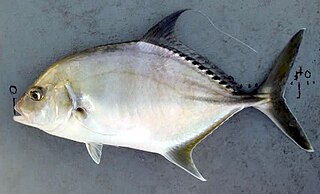
The coachwhip trevally, also known as the oblong trevally or oblique-banded trevally, is a species of inshore marine fish classified in the jack family Carangidae. The coachwhip trevally is distributed through the Indo-west Pacific region, ranging from South Africa in the west to Fiji and Japan in the east. It is a moderately large fish, growing to a known maximum length of 46 cm and can be distinguished from similar species by an array of detailed morphological features including dentition, fin ray counts and scale patterns. The coachwhip trevally inhabits coastal waters throughout its range, known to prefer estuarine waters in a number of localities. Nothing is known of its diet or reproductive biology, and is of little importance to fisheries, occasionally taken as bycatch in trawl and hook and line fisheries.

The Atlantic torpedo is a species of electric ray in the family Torpedinidae. It is found in the Atlantic Ocean, from Nova Scotia to Brazil in the west and from Scotland to West Africa and off southern Africa in the east, occurring at depths of up to 800 m (2,600 ft), and in the Mediterranean Sea. Younger individuals generally inhabit shallower, sandy or muddy habitats, whereas adults are more pelagic in nature and frequent open water. Up to 1.8 m (6 ft) long and weighing 90 kg (200 lb), the Atlantic torpedo is the largest known electric ray. Like other members of its genus, it has an almost circular pectoral fin disk with a nearly straight leading margin, and a robust tail with a large triangular caudal fin. Distinctive characteristics include its uniform dark color, smooth-rimmed spiracles, and two dorsal fins of unequal size.

The Portuguese blenny, also known as the red blenny, is a species of combtooth blenny found in the eastern Atlantic ocean off western Europe and Macaronesia.

Caristius is a genus of manefishes native to the Atlantic and Pacific Oceans.
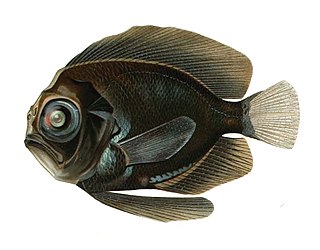
Platyberyx is a genus of manefishes native to the eastern Atlantic Ocean.

The black margate, also known as black bream, black thicklip, dogfish, lippe, Mexican bull, pompon, Spanish grunt, surf bream, sweetlips or thicklip grunt, is a species of marine ray-finned fish, a grunt belonging to the family Haemulidae. It is native to the western Atlantic Ocean.
Merluccius polli, the Benguela hake, is a species of fish from the family Merlucciidae, the true hakes. It is found in the tropical waters of the eastern Atlantic Ocean off the west coast of Africa.

Hirundichthys rondeletii, the black wing flyingfish, is a species of flying fish from the family Exocoetidae which is found throughout the tropical and subtropical waters of the Atlantic, Pacific and Indian Oceans.
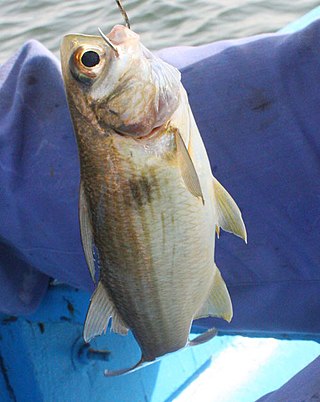
The lesser African threadfin is a species of marine ray-finned fish, a threadfin from the family Polynemidae which is found in the eastern Atlantic Ocean off the western coast of Africa.

The royal threadfin is a species of ray-finned fish, a threadfin from the family Polynemidae, the threadfins. It is found in the eastern Atlantic Ocean along the western coast of Africa.

The African forktail snapper, is a species of marine ray-finned fish, a snapper belonging to the family Lutjanidae. It is found in the eastern Atlantic Ocean.

















